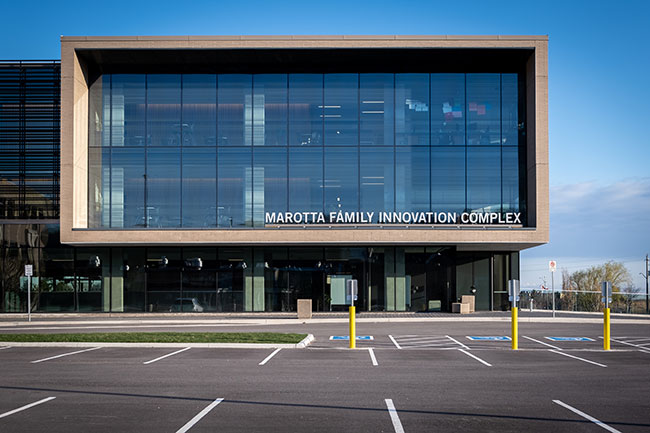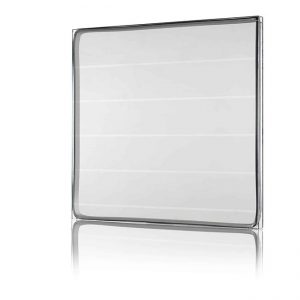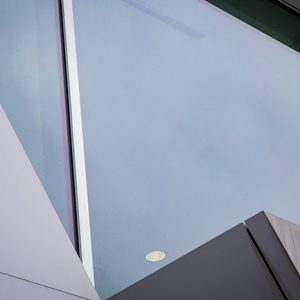
Uncategorized
Codes and standards
Architectural design
Contracting
Go bird-friendly – Glazing that prevents bird strikes is becoming law across the land
What you need to know about bird-friendly glass
March 3, 2021 By Adam Mitchell
 Ongoing research as shown that a visual cue must be used on surface one in order for birds to avoid the glass surface. But this creates some challenges for glass fabricators.
Ongoing research as shown that a visual cue must be used on surface one in order for birds to avoid the glass surface. But this creates some challenges for glass fabricators. Bird-friendly. It seems like we hear it all the time, but what do we need to know in order to best satisfy our clients’ needs, budget and building aesthetic?
Building designs, facade materials and green initiatives continue to evolve and interplay as urban areas move into an eco-conscious era. From the growing use of electric cars, to energy-saving devices, to thermostats and smart HVAC systems, the green evolution is becoming ubiquitous. Glass in and of itself is a recyclable material, and coating innovations improve overall building efficiency. So glass figures to be a material of choice in green design.
As an industry, our goal has been to establish buildings that are habitable and healthy for humans. The use of low-E coatings, insulated glass units, interlayers and glazing all play a part into how large a glass system can be while maintaining a comfortable living and working space. From an environmental standpoint, these same technologies play a pivotal roll in a building’s thermal insulation, solar heat gain characteristics and overall energy conservation.
Many of these innovations have been inward to best serve both human and energy conservation requirements, but now the evolution of exterior architectural glass is underway, generating a fully realized, green, eco-conscious product from the inside out.
The issue
Up to one billion bird strikes are estimated in the U.S. and up to 25 million strikes are estimated in Canada every year. This staggering number of bird fatalities typically occurs from low-rise and residential buildings.
To put this figure into perspective, one of the worst environmental disasters in history, the Exxon Valdez, killed an estimated 250,000 birds. Thus, the toll windows have on the wild bird population is the equivalent of up to 4,100 Exxon Valdez spills every year.
A leading figure in the study of bird strikes is Dan Klem, Jr. who has been studying bird collisions since 1974. According to Klem and his sizeable body of research, birds simply can’t see glass. More specifically, window reflection is the leading cause of daytime bird strikes, while lights left on after sundown are the leading cause of nighttime strikes.
The answer to the nighttime issue is evident: turn off building lights. The American Bird Conservancy’s Lights Out recommendations are focused on educating building operators on this phenomenon and taking corrective action. However, daytime strikes are not so clear-cut. Due to reflection a visual cue must be used on surface one to assist birds in seeing the glass object.
Lastly, a majority of bird strikes fall below a 16-foot height due to the fact this is a common measure of trees and objects necessary to land, nest and rest.
From a legislative standpoint, federal, provincial and municipal requirements surrounding bird-friendly design are coming to fruition. Toronto led the way in specific municipal mandates regarding bird-friendly building conformance. Since 2010, the city has required new developments to adhere to the Toronto Green Standard, which contains bird-friendly mandates.
For example, on new buildings that require bird-friendly glass, visual markers can be no smaller than five millimetres and no greater than 100 millimetres apart. Dependent on the building type and location, 85 percent of the lower level (below 16 to 18 feet) must contain bird-friendly glass. The mandate also contains all variants one may face including buildings on grades, glass balconies, fly-through conditions, parallel glass surfaces and rooftop vegetation.
In Toronto, all new building designs must comply with the Toronto Green Standard, which are then approved through the planning approval process.
It’s not a matter of if you need to know bird-friendly glass as a glazing professional – the requirements are already here. The following is what you need to know to best satisfy a client’s specifications.
Know your standards
In 2019, the Canadian Standards Association released their first document to solidify the practice of bird-friendly building design. The standard, CSA A460:19 takes a prescriptive approach to bird-friendly design and construction, taking into consideration an enormous body of resources, including opacity and geometry of facade materials, in order to best mitigate fatalities.
For architectural glass, the two-by-four inches rule is the gold standard deterrent. What is the two-by-four inches rule? It is a guideline that states horizontal lines or patterns must not be more than two inches apart, while vertical lines or patterns can be no more than four inches apart. Keep this in mind as a rule of thumb when considering which bird options will perform the best.
Surface one – It’s your time to not shine
“Because daytime strikes are often attributed to exterior reflection, it is necessary for visuals to be on surface one for best effectiveness,” says Marc Deschamps, director of products and business development at Walker Glass Company.
Bird-friendly glass comes in a variety of options, all of which have benefits and drawbacks. As a glazier, here is a running list of what you should know.
#1 Etched glass
As the name suggests, acid etch glass specific to bird-friendly applications. The etch must be on surface one. First are the size considerations: etched bird-friendly glass is available in 96-by-130 inches maximum. Next, thickness considerations. Thicknesses range from three to 12 millimeters. Available makeups include clear, low iron or tinted glass substrates with or without low E on the second surface. Eteched designs include lines or dots two inches by two inches to four inches by four inches and can feature organic patterns as well. The design will only be effective if it follows the two inches by four inches rule. An example of an etched bird-friendly product is Walker Glass’ AviProtek E Pattern 215.
#2 UV Coated
The UV coated option appears transparent to humans, but completely visible to birds in the 300-400 nanometre spectrum. It’s available up to 102 by 144 inches from Guardian BirdFirst or 96 by 130 inches from Walker AviProtek T. Thicknesses are six millimetres with special considerations. Aviprotek T offers a UV marker on surface 1 on clear or low iron glass; SN 62/27, SN 68, and NU 78/65 from Guardian BirdFirst also has the technology. The designs are two-inch bars, lines, patterns or dots, two inches by four inches
#3 Custom-printed frit
Printed frit is a dot pattern that allows for oversized glass dimensions and creative branding solutions. This option is the most versatile with the ability deliver on varying thicknesses and glass types. It is scalable from one to hundreds of custom dimensions. At Agnora, we can do 130 by 300 inches on our DipTech printer. Six- to 19-millimetre thicknesses are possible.Because it’s a custom item, the makeup of bird-friendly fritted glass can be specified at the time of order. Designs can include lines, patterns, dots or a custom design.An example of a custom frit bird-friendly product is Pilkington OptiWhite with a two inches by two inches custom shape or oversized.
- Walker Glass’s AviProtek T is an example of the UV-Coated variety of bird-friendly glass.
- Dots on the glass surface act help birds avoid fatal collisions.
Use case as a glazier
In the previous section we described the attributes of materials. In this section we will explore the pros and cons of each type to help you ask right questions and select the correct architectural glass product.
To create oversized printed frit, Agnora employs the Dip-Tech NEraD Series ceramic printer and its unique ability to print oversized architectural glass. This $3 million investment in print technology allows for any design to be applied to the glass substrate and projects often extend in scope beyond traditional bird frit. “We see a huge number of specialized projects,” says Joe LindseAgnora’s digital print specialist. “The Dip-Tech is a phenomenol tool and it allows us to use a great range of colour, opacity and custom mixtures to create unique results such as art prints, custom edge frit or bird frit.”
Other considerations, specifically for bird-friendly glass includes dot alignment between units and limits on the final glass sizing. “Bird-friendly glass is still in its infancy,” says Lindsey. “We see people just asking for bird-friendly, without detailing the type of pattern, opacity, spacing and even alignment between lites or IGU’s that they want. These are all things that need to be considered. These are all things that are important to the look of the final installation. It’s better to get it correct from the beginning.”
Each of the above scenarios should be considered when either designing for a bird-friendly application, adhering to a specification or selecting replacement lites for a project. These important considerations should also be accounted for when choosing to align yourself with a bird-friendly product and fabricator.
In closing, do not think of bird-friendly as a product that is just a “check box,” but rather an opportunity to help define an esthetic for a building and helping to achieve an architectural vision while conforming to requirements and eco-conscious design. As requirements for bird-friendly glazing become more common in Toronto and beyond, we will all have to use our creativity to continue to produce great facades that also protect our feathered friends.
Etched Glass
Pros
- A number of style options
- Medium-sized application up to 96 inches by 130 inches
- Low-E coating option
- Economical cost
- Highly durable marker on surface one with a 10-year warranty
Cons
- Size limitations. Typically, these products range in the “medium” sized glass and may be difficult to implement for oversized applications.
- Pattern visible to the naked eye
- Alignment and design consideration to produce the best building esthetic can be challenging.
- May require frequent cleaning in dense urban areas.
UV Coated
Pros
- This product is incredibly effective against bird strikes, while being all but clear to the human eye. Extremely durable.
- Low-E coating option
Cons
- Size limitations. Typically, these products range in the “medium” sized glass and may be difficult to implement for oversized applications.
- May require lamination
- A UV coating may require the same type of glass (and size) to be used throughout the entire project for consistency.
- Can be very expensive
Custom-printed frit
Pros
- Printed frit allows for the use of oversized glass, up to approximately 130 inches by 300 inches for oversized application.
- Design of the dots and dot pattern can be unique, and even branded.
- An efficient square-foot cost on par with etched glass
- Various glass types and suppliers can be used.
- Can be laminated with any coated glass.
Cons
- Dot pattern visible to the naked eye
- Alignment and design consideration to produce the best building esthetic can be challenging.
- May require frequent cleaning in dense urban areas.
Print this page

